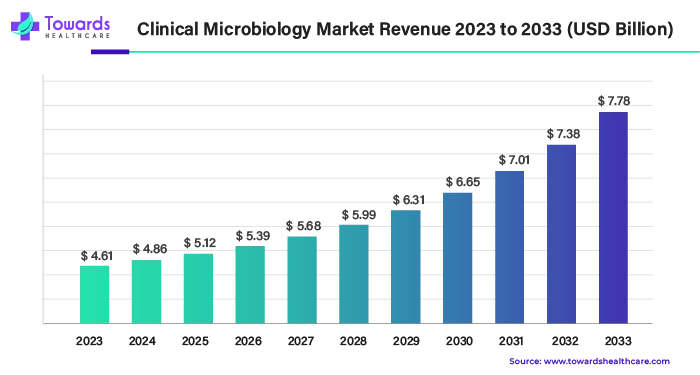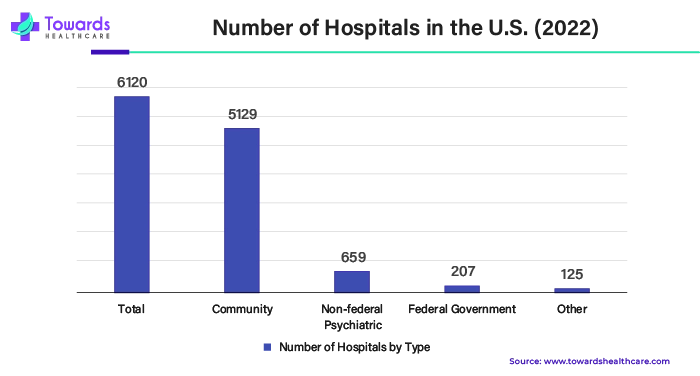March 2025

.webp)
Principal Consultant

Reviewed By
The global clinical microbiology market size was valued at US$ 4.61 billion in 2023 is expected to reach US$ 7.78 billion by 2033. It is poised to grow at a compound annual growth rate (CAGR) of 5.37% from 2024 to 2033. The increasing prevalence of infectious diseases is driving the market’s growth.

The medical field that studies the prevention, treatment and cure of infectious illnesses is covered by the clinical microbiology market. A medical microbiologist investigates the properties of pathogens, including growth, infection, and route of transmission. Improved diagnosis accuracy and shorter turnaround times are the consequences of recent technology developments. Examples of developments are the advent of mass spectrometry for the proteomic identification of microorganisms and the automation of the processing and incubation of bacterial cultures. Over the past few decades, a number of components in the clinical microbiology laboratory have been automated. Automated blood culture equipment, automated platforms for assessing antibiotic resistance, automated nucleic acid extraction, and other automated innovations are examples of automation developments. This continuous adoption of technology, along with automation, is boosting the growth of the clinical microbiology market.
| Company Name | T2 Biosystems Inc. |
| Headquarters | Massachusetts, U.S. |
| Recent Development | In March 2024, T2 Biosystems, Inc., a pioneer in the quick identification of sepsis-causing bacteria and genes linked to antibiotic resistance, revealed plans for the commercial launch of the T2Lyme Panel and gave an update on recent business developments. Leading the way in the quick identification of sepsis-causing bacteria and antibiotic resistance genes, T2 Biosystems is committed to lowering healthcare costs and enhancing patient outcomes by enabling physicians to treat patients more quickly and efficiently than ever before. The Candida auris test, the T2LymeTM Panel, and the U.S. T2Resistance Panel are among the next products that T2 Biosystems is actively developing. |
| Company Name | Entos Pharmaceuticals |
| Headquarters | Alberta, Canada |
| Recent Development | In January 2024, with its Fusogenix proteolipid vehicle (PLV) nucleic acid delivery platform, Entos Pharmaceuticals, a clinical-stage biotechnology firm, is creating genetic medications. The business just opened a new GMP production facility in Carlsbad, CA. The company's pipeline of partnered and proprietary products will undergo clinical trials and IND-enabling research, with the new location supporting the in-house manufacture of therapeutic material. The plant has 20,000 square feet of area set out for manufacturing, with separate suites for the manufacture of mRNA and plasmid DNA in addition to a lipid formulation production suite. The goal of this laboratory is to assist in the clinical development of COVID-19 booster vaccines, such as Covigenix, as well as potential treatments for cancer, infectious illnesses, uncommon disorders, and eye and ophthalmic ailments. |
With the advent of molecular biology methods and laboratory automation during the past ten years, clinical microbiology laboratories have seen significant changes. Faster diagnosis, more testing uniformity, and improved flexibility will be required in the future to handle emerging diseases and bioterrorism agents, among other infectious microorganism concerns.
AI is being incorporated into several areas of microbiology, including virology, parasitology, mycology and bacteriology. The successful use of AI in microbiology has been accelerated by the combination of AI with cutting-edge data-gathering tools, increased processing capacity, and international networks—typified by Big Data, Moore's Law, and the Internet. This combination is especially clear in the area of medication creation, where AI-powered methods are paving the way for the creation of cutting-edge antibiotics to battle organisms that are resistant to multiple drugs, a growing threat to world health.
In poor nations, the primary cause of mortality is still infectious illnesses. There is no end in sight to the HIV epidemic, and the prevalence of tuberculosis (TB) is rising concurrently with it. Many sentinel hospitals have subpar microbiological laboratory capabilities. Microbiology tests are frequently unavailable due to prohibitive costs and questions about the cost-effectiveness of particular testing. Inadequate laboratory management and inadequate infrastructure have led to dangerous outcomes in the majority of developing nations. The creation of a molecular microbiology facility in a microbiology lab is yet dispersed.
In order to bypass the time-consuming and carbon-intensive traditional ground transport techniques, two viable options for sample transfer between hospital units and microbiological laboratories in the future are drones and intra-site pneumatic transportation systems. The field of clinical microbiology has a lot of room to expand because of the potential applications of drones in epidemiology, infectious illnesses and clinical microbiology. Because of their remote location, lack of infrastructure, or lack of financial resources, those who may not otherwise benefit from adequate treatment may find that access to healthcare is increased because of drones. In the next five years, drone application in many medical fields is likely to be driven by significant cost reductions as compared to ground transportation, delivery speed and convenience, and the expanding drone industry.
By instruments, the laboratory instruments segment held the largest clinical microbiology market share in 2023 and is estimated to grow at the fastest growth rate during the forecast period. Sterilization, storage, and sample culture are all accomplished with a range of instruments and equipment used in microbiology labs. It is possible for microbiologists to operate in an enclosed area known as a biosafety cabinet, which keeps ambient bacteria and microbial samples apart. Scientific research is built on data that is accurate and trustworthy. With the use of laboratory equipment, scientists may regulate and work with variables to guarantee accurate observations and results. It would be challenging to derive reliable findings from tests without the proper equipment since they would be prone to mistakes and inconsistencies.
By disease area, the respiratory diseases segment dominated the clinical microbiology market in 2023 and is anticipated to grow exponentially over the forecast period. Respiratory illnesses are a frequent cause of disease and death worldwide. For optimal patient treatment, including the selection of antiviral or antibiotic medicine, effective infection control measures, and a reduced length of hospital stay, a prompt and accurate diagnosis of a respiratory tract infection is crucial. Furthermore, both microbiological and virological approaches must be used in laboratory diagnosis in order to be very informative concerning strain type, epidemiological surveillance, outbreak management and antibiotic susceptibility.
By application, the pharmaceutical application segment had the largest revenue share of the clinical microbiology market in 2023. A crucial part of guaranteeing the security and effectiveness of pharmaceuticals is clinical microbiology. This area of study focuses on microorganisms that are important to the pharmaceutical sector and includes the investigation of bacteria, viruses, fungi, and other microbes that may have an effect on the quality of pharmaceutical goods. Pharmaceutical microbiology's main objective is to stop and manage microbial contamination that occurs during the production, storage, and delivery of medications. Strict testing procedures are utilized to evaluate pharmaceutical formulations for sterility, stability, and general microbiological quality. By maintaining the standards of pharmaceutical goods, microbiological methods play a crucial role in pharmaceutical quality assurance and the protection of public health.
By end-user, the hospitals and diagnostic centers dominated the clinical microbiology market in 2023. In order to facilitate the diagnosis, treatment, and management of diseases, clinical microbiology is primarily concerned with the identification, description, and quantification of pathogens from patient samples. Clinical microbiologists need to be proficient in all facets of microbiological testing, including the pre-analytic and post-analytic stages. Additionally, the hospital epidemiologist receives epidemiologic data from the microbiology laboratory to aid in the prevention, identification, investigation, and containment of nosocomial epidemics. The knowledge from the clinical microbiology laboratory, when applied appropriately and quickly, enhances clinical results, lowers needless antibiotic usage and stops nosocomial infections.
By region, North America dominated the clinical microbiology market in 2023 and is estimated to remain dominant throughout the forecast period. There are various factors that contribute to the dominance of North America, including advanced healthcare infrastructure, continuous research & development, government support & funding, the presence of major market players and the prevalence of infectious diseases. North America also dominates different industries, such as food and beverages, environmental applications, biotechnology, pharmaceutical, healthcare, and so on, which require clinical microbiology for various testing and diagnosis, which boosts the growth of the clinical microbiology market in the North American region.
The U.S. holds the largest share of the market in the region and worldwide. The U.S. has one of the most advanced healthcare systems. Whether expressed as a percentage of GDP or as an absolute amount, the U.S. spends more on healthcare than any other nation. Across the nation, there are adequate hospital facilities that consistently drive demand for clinical microbiology products in the areas of diagnostics and treatments.

Apart from the advanced health infrastructure, the U.S. faces challenges associated with different diseases that need continuous assessment. Respiratory diseases are growing, followed by bloodstream infections. The government is taking several initiatives to tackle these health issues, which will boost the growth of the clinical microbiology market.
For instance,
Asthma is the most expensive respiratory disorder, followed by COPD, according to data released in January 2023 by the National Library of Medicine. The overall cost of all respiratory diseases in the United States was $170.8 billion. It was inpatient care (28.8%) and prescription drugs (28.5%) for COPD. Hospitalization expenditures were for the greatest portion of overall spending for interstitial lung disease, accounting for about 62.8% of it. The two types of care with the highest expenditures for upper respiratory tract infections were ambulatory (58.1%) and emergency department (21.7%). Nearly 70% of COPD expenses were covered by public insurance.
By region, Asia Pacific is estimated to grow at the fastest CAGR between 2024 and 2033. Asia Pacific is the largest region with the largest population, which contributes to the growth of the clinical microbiology market. The region is continuously focusing on establishing advanced healthcare facilities and infrastructure, especially after the prevalence of COVID-19. Countries like China, India, Japan and South Korea have mainly contributed to the growth of the market.
China has advanced significantly in the field of clinical microbiology research. All around the nation, China has highly developed healthcare facilities. China has 1.071 million medical and health facilities by the end of 2023, with 39,000 hospitals among them. Out of the total number of hospitals, 27,000 were private, and 12,000 were public. 34 thousand town and township health facilities, 37 thousand community health care centers, 362,000 clinics, and 583 thousand village clinics made up the 1.016 million medical and health institutions at the grassroots level. 2,791 health monitoring institutes and 3,426 disease control and preventive centers made up the twelve thousand professional public health institutions. In 2023, there were 9.56 billion medical visits and 0.3 billion hospital discharges overall.
By Instruments
By Disease Area
By Application
By End-User
By Geography
March 2025
March 2025
March 2025
March 2025